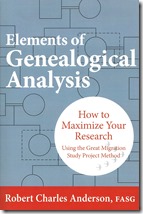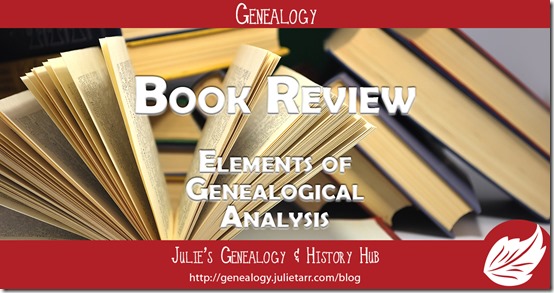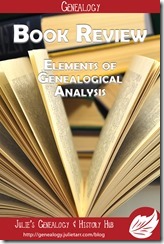 Title: Elements of Genealogical Analysis: How to Maximize Your Research Using the Great Migration Study Project Method
Title: Elements of Genealogical Analysis: How to Maximize Your Research Using the Great Migration Study Project Method
Author: Robert Charles Anderson
Format: Paperback
Published: 2014
My Rating: ![]()
![]()
![]()
![]()
The following review first appeared in the Federation of Genealogical Societies FORUM magazine (Summer 2015); reprinted with permission.
There are plenty of how-to guides available for genealogy researchers, covering a variety of topics from record types to locations and everything in between. While some of the more general genealogy how-to books set forth a basic research process, oftentimes their main goal is to introduce the reader to researching various sources found in certain times and/or places. Robert Charles Anderson, on the other hand, has prepared a guide focusing solely on the research process, particularly dealing with methods of analysis and problem solving. He does not “contend that any of the elements in this system is new,” instead he claims that “what is new here is the arrangement into a comprehensive program” (xv). Indeed, Elements of Genealogical Analysis is a “problem-solving system” designed to take researchers through the steps necessary for conducting sound research in order to solve even the toughest genealogical problems.
Mr. Anderson developed the basis of this methodology, what he calls the “two Fundamental Rules,” in the early 1980s. Those rules were the beacons he followed when he took on the Great Migration Study Project in the late 1980s. His continued work on the Project over the last 20-plus years allowed him to cultivate the problem-solving methodology discussed in this book.
In the overview portion of the book, Mr. Anderson proclaims his two Fundamental Rules, which are not unlike the five elements of the Genealogical Proof Standard (GPS) with which many genealogists are already familiar. These fundamental rules are applied to research problems using the analytic tools and problem-solving sequence that make up parts one and two of the book.
In the first part, readers will learn techniques for analyzing sources and records, as well as determining whether two or more records pertain to the same person (what Mr. Anderson refers to as “linkage analysis”). Part two takes the reader through a problem-solving sequence, consisting of five steps, from identifying the problem to solving the problem. Each chapter is full of well-constructed case studies that provide illustrative examples of the concepts discussed.
In many cases, genealogists already follow these same ideals and principles while conducting their research. What makes this book important is the arrangement of these concepts into a practical framework. Using such a framework provides a vivid awareness of the steps involved and helps researchers document their thoughts and reasoning at each point. Some may think the system is a bit extreme, especially for simple genealogical research problems. But, as readers move through the book, it becomes quite clear why such a methodical approach is necessary to ensure one’s conscientious attention to detail and accuracy.
Keep in mind that this particular methodology was developed by Mr. Anderson based on his personal experience and is presented in a format that has worked for him for many years. Therefore, some concepts may be new to the reader, as may some of the terminology, all of which are explained and defined throughout the book (a glossary of terms is provided among the appendixes).
Also remember that this is one perspective in a field of many, and what works for one person may not work for another. However, learning from others is key to a genealogical researcher’s improvement, so keeping an open mind and devouring every perspective out there is a great strategy for personal development. Everyone can learn something from this book, whether a seasoned researcher or someone just starting their genealogical journey. So go on, pick up a copy and absorb all the wisdom Elements of Genealogical Analysis has to offer.



Share your thoughts...